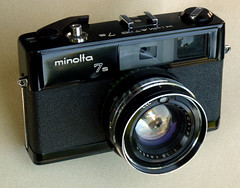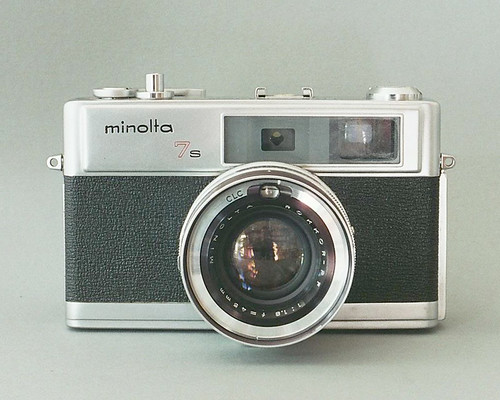Minolta Hi-Matic 7s
| Minolta Hi-Matic 7s |
|---|
|
Manufacturer: Minolta
Film type: 35mm
|
The Minolta Hi-matic 7s was introduced in 1966. It was the second upgrade of the Hi-Matic line.
Contents
Predecessor: the Hi-Matic 7
In 1963 the Minolta Hi-Matic 7 succeeded the original Minolta Hi-Matic 35mm rangefinder camera. It had new features, especially a CdS meter placed above the lens optics within the filter ring, a manual shutter speed selection mode, and the exposure meter's actual EV-value displayed in the viewfinder. Like the original Hi-Matic its viewfinder was a rangefinder with mechanical parallax correction, and it had a self-timer. With this camera Minolta made the "Hi-Matic" camera series their main series of range- and viewfinder cameras. Every Hi-Matic had auto-exposure, and increasing support for flash use.
Features of the Hi-Matic 7s
The Hi-Matic 7s and Hi-Matic 9 followed in 1966, and were improved versions of the 7. The 7s came with the Contrast Light Compensator (CLC) metering system, which offered improved metering, especially in high contrast situations. Also the 7s added a hot shoe and Safe Load System (SLS) indicator to show that film was loaded and being transported properly. Additional differences between the 7 and 7s included rangefinder windows changing from a contrasting 'pink and green' tint to 'yellow and blue'; the carrying strap lugs moving up to the side and given a more rounded shape; and the end of the lens barrel being black rather than the brushed aluminium of the 7. The 7s also came in a black version.

|
| Hi-matic 7s Black Version image by Paulo Moreira (Image rights) |
Evaluation
Modern Photography evaluated the Hi-Matic 7s in 1967 after its release.[1] In general they noted that it operated similarly to the Hi-Matic 7. They found that CLC meter was within 1/2 stop of their test reference, and field tests with transparencies were well exposed despite a variety of light and contrast. They also liked that the meter could be switched off to prevent battery drain, and they liked the SLS indicator, which not only showed that the film had been loaded correctly but also tracked film usage. Because the lens of the 7s was the same as the 7, Modern Photography did no lens test of the 7s, and simply repeated the lens test results of the 7.[2]
| Aperture | Center Sharpness |
Edge Sharpness |
|---|---|---|
| 1.8 | Good | Acceptable |
| 2.8 | Good | Acceptable |
| 4 | Good | Good |
| 5.6 | Good | Good |
| 8 | Good | Very Good |
| 11 | Good | Very Good |
| 16 | Good | Very Good |
| 22 | Acceptable | Good |
References
Pictures

|

|

|

|
|
The Minolta Hi-Matic 7s | |||
